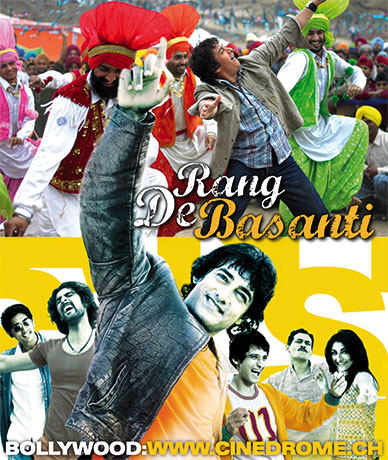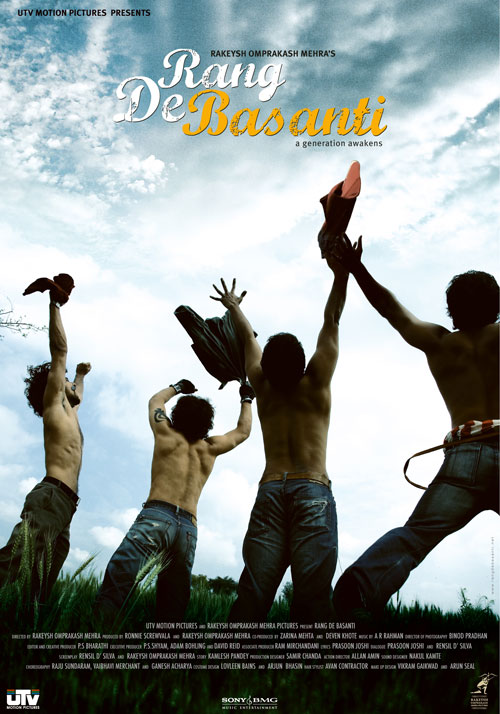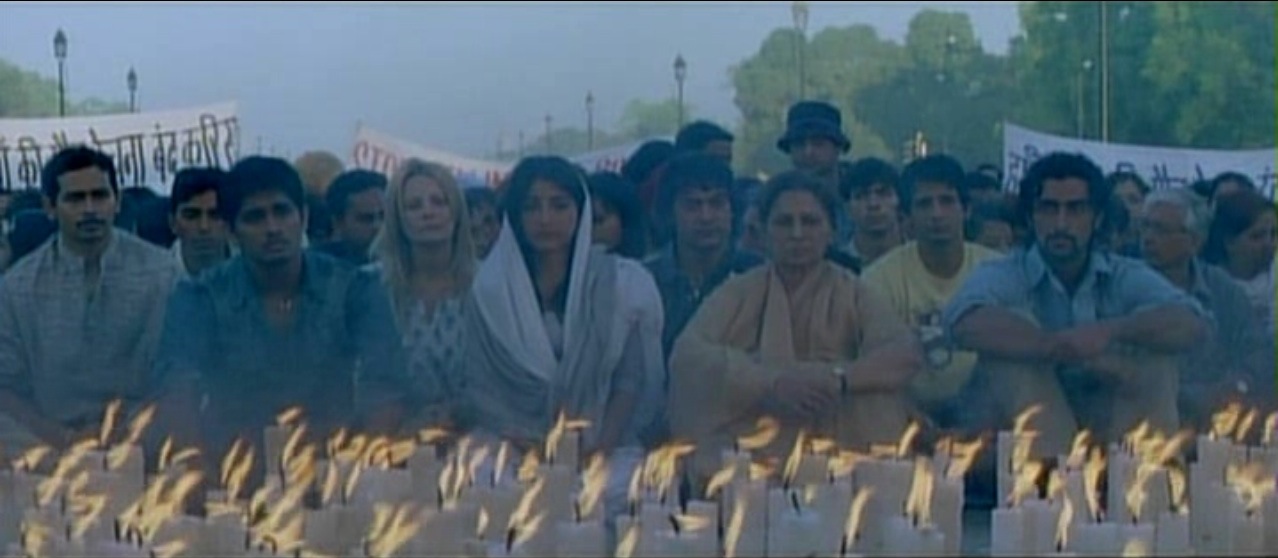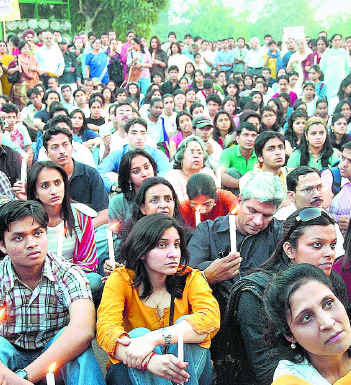1. Introduction
[1.1] Rang De Basanti (Paint it saffron) was a patriotism- and social change-themed Bollywood film that was strategically released in India and other countries on January 26, 2006, India's Republic Day (which commemorates the day when the Indian Constitution came into effect). It was a significant commercial and critical success, earned numerous awards, and was nominated for the British Academy of Film and Television Arts (BAFTA) award for best foreign-language film. Despite these accolades, Rang De Basanti's greatest legacy might be its role (unusual for a Bollywood film) in helping generate civic activism among urban Indian youth aimed at securing justice in a high-profile murder case.

Figure 1. Aamir Khan, pictured in the center, has been one of Bollywood's most popular actors and icons for more than two decades. Rang De Basanti featured Khan playing a 20-something college student.[View larger image.]
[1.2] Here I present flash activism, a model of fan activism based on the sociocivic protests, emulating the film, that occurred in the wake of its release and the coinciding, controversial court verdict. After chronicling the events, I elucidate flash activism, compare it to Punathambekar's (2010) mobile publics, and consider its critical function in sustaining the fabric of civil society, a term that I interpret differently from the literature.
2. The case

Figure 2. Rang De Basanti's promotional posters had a striking visual aesthetic that appealed to young people's aspirations to break societal boundaries by reaching for higher levels of freedom of self-expression and camaraderie.[View larger image.]
[2.1] Rang De Basanti (hereafter RDB) narrates the gradual transformation of five college friends from happy-go-lucky, politically apathetic youngsters to antigovernment rebels. The death of a close friend, a fighter jet pilot, is a catalyst, when the Aviation Minister falsely blames the pilot's foolhardiness for the crash instead of admitting the plane was a model long known to be defective, which the Minister had been bribed to procure. To protest, the friends organize a peaceful candlelight vigil at India Gate, a prominent landmark in the capital, New Delhi. The vigil is violently disrupted by the police, and the last third of the film shows the dramatic repercussions of this violence. The film's provocation is best captured in one line of dialogue: "No country is perfect. You've got to make it perfect."

Figure 3. The candlelight vigil at India Gate in Rang De Basanti.[View larger image.]
[2.2] RDB had a momentous impact on audiences, especially youth, who were drawn to theaters by its visually attractive ad campaign, upbeat score, and the star power of cast member Aamir Khan. Meghana Dilip observes there was a "significant" postrelease increase in the discussion of political issues on Indian blogs (2008, 30). The frustration evident on some blogs—"[RDB] is an emergency-wake up call for the youth in India to take the cause of freedom seriously" (37); "The society will be ruined by these evil politicians. Its time to have a Rang De Basanti type resurgence" (32)—reflected the frustrations showcased in the film's final moments. Dilip opines that Hindi cinema can be surprisingly "ideology-filled…Its raw material is the society of today," and that this motivates audiences "to act in certain ways" (7). Indeed, in the weeks following the film's release, it did seem that change was in the air, since many were unexpectedly moved by the film's story and ideology.
[2.3] Still, several commentators, including Dilip, agree that RDB's most prominent impact was on the ongoing real-life trial of Manu Sharma and a number of others for the murder of Jessica Lall. On the night of April 29, 1999, Lall, a 34-year-old fashion model, was doubling as a waitress as part of a publicity campaign for a newly opened fancy New Delhi restaurant. At around 2 AM, Sharma, the young son of a high-ranking politician and member of the city's elite brat pack, entered with his friends and demanded that Jessica serve them drinks. It was past closing time, so she refused. He then pulled out his gun and fatally shot her point-blank, in the presence of 300 of the city's glitterati.
[2.4] As is common in India, the case dragged on in the courts for several years, over which period many witnesses recanted (having been bribed or threatened) and the murder weapon went missing. Then, on February 21, 2006, four weeks after the release of RDB, a Delhi trial court acquitted Manu Sharma and his friends on the grounds of insufficient evidence.
[2.5] This appalling verdict unleashed an unusually vehement public outcry. A day after the acquittal, a Times of India headline screamed, "No One Killed Jessica." The Week expressed its disgust with a cover story titled "How the Rich Get Away with Murder." NDTV, a 24-hour news channel, submitted to the president of India the more than 200,000 cell phone text messages it collected in response to its "SMS Jessica to 3636" campaign. And the blogosphere continued to galvanize people's frustration and anger.
[2.6] However, the response that received the most media attention was, in fact, directly inspired by Rang De Basanti. A few days after the verdict, Tehelka, an Indian weekly, sent an anonymous text message: "If the Jessica case has upset you, show you care. There is a protest gathering at India Gate next Saturday, March 4 at 5.30pm. Be there. Help keep up the pressure. Demand justice." It is not clear whether Tehelka deliberately chose India Gate to draw a parallel to RDB.
[2.7] That evening about 2,500 people, many of them students, gathered for a candlelight rally at India Gate. This is noteworthy for many reasons. In Shoma Chaudhury's words, "Delhi's middle class is infamously apathetic and insular," and it was far from clear that it would "take its outrage to the street" (2006). Evidently, many who received the text message were moved enough not only to pass it on but also show up. Yet what is most remarkable is that the protest was a replication of the crucial scene of a candlelight vigil at India Gate in Rang De Basanti, which had been released six weeks prior and was firmly alive in public memory and blogosphere discourse. In fact, candlelight vigils were a fairly unusual form of protest in 2006; the Times of India called them "a novel idea" (Lamchane 2006a).
[2.8] What unified the assembled group was a "quiet rage" at the injustice of the verdict, their demand for the case to be reopened and Manu Sharma hanged, and their "yearning for something purer." Chaudhury reports,
[2.9] A curious undercurrent of theatricality underran the entire evening. Several people who took the mike that day referred to Rang De Basanti: at times it seemed more than the injustice itself, the film was their inspiration. It had not just intuited a latent public mood; in a curious twist, it had become the mood itself. (Chaudhury 2006)
[2.10] Moreover, a survey conducted shortly thereafter by the influential Bombay Times revealed that a significant number of people attributed the recent upsurge in social movements to RDB (Lamchane 2006b). Clearly, RDB had become a force to reckon with and had had a direct impact on civic engagement.

Figure 4. Protesters, largely middle-class residents of Delhi and many of them students, hold a real-life candlelight rally at India Gate after the acquittals.[View larger image.]
[2.11] Crucially, this rally, along with the concomitant intense media scrutiny, resulted in the reopening of the trial and a stunning outcome in December 2006: Manu Sharma was found guilty of murder and sentenced to life imprisonment. Justice was meted out in a country with a long history of powerful criminals (many of them politicians) going scot-free, and of a conditioned apathy about it among the public.
3. Flash activism and flash fandom
[3.1] The "RDB Syndrome" (Saxena 2007) manifested in the India Gate protest is a case of what I call flash activism. Flash activism is a temporary social mobilization around a particular civic issue; it may or may not have clear-cut goals, and may or may not achieve these goals. At least two factors are responsible for this mobilization: (1) an existing group of people (specifically, a fandom; more below) already sensitive to and wishing to foster a civic ethos, and (2) external triggers, which may be cultural media artifacts like film, music, theater, and television.
[3.2] In particular, when media artifacts mobilize flash activism, we may speak of flash fandoms catalyzing flash activism. RDB's plot, score, marketing, and underlying ideology successfully predisposed its audiences to action. People became fans of the movie, but the full extent of their fandom remained latent until an external event could release their passion, their reasons for being moved. A flash fandom, then, is a latent admiration of a cultural artifact that is deep enough to mobilize and transform the central values driving people's lives. An external event or issue may allow for the manifestation of a flash fandom in the form of flash activism.
[3.3] I use the word flash to emphasize the suddenness and the self-organization of the activism, as well as the suddenness of the self-organization. In this sense, flash activism can be superficially yet productively compared to Steven Johnson's (2001) principle of bottom-up emergence, a paradigm he believes defines this age. Johnson's emergent systems are adaptive and they self-organize, and even though his examples do not include civic protest, he stresses the importance of a "critical mass" of agents, a productive "ignorance" in individual agents, and attention to the activities of neighboring agents (78–79). Thus he defines emergence as "the movement from these low-level rules to higher-level sophistication" (18), a movement that could not have been predicted only by observing the rules being played out.
[3.4] In the case of the India Gate protest, the participants—as RDB fans, Jessica sympathizers, or simply middle-class people tired of injustice—were ordinary citizens, individually relatively powerless, who, operating in an environment awash in RDB-induced civic pride and Jessica-induced civic disgust, felt compelled to "listen to their neighbors," tap into their "agency," and pass on the text message. Tehelka, recognizing the ripening of people's restlessness in the wake of RDB, appropriated the simplicity and iconicity of the film's turning-point scene at India Gate; both of those qualities probably helped the text message reach a "critical mass." In the end, what emerged was a passionate voice that was unprecedented, unexpected, and unpredictable (Johnson 2001).
[3.5] One characteristic, then, that distinguishes flash activism from superficially similar social protests is its tie to flash fandoms; the concepts go together. A latent fandom tied to a media or cultural artifact is necessary for that fandom to manifest in flash activism, but it is not sufficient. An external catalyst is also key. Flash fandom, then, isn't like ordinary fandom. It is in essence contingent: its catalysis (i.e., its manifestation) occurs at exactly the same moment that its members express it as flash activism.
[3.6] To further understand flash activism, it might be helpful to compare it to Aswin Punathambekar's (2010) notion of mobile publics. Punathambekar conceived of mobile publics in response to another recent Indian media phenomenon: the passionate cheering and voting—via mobile media such as cell phones—by the people of the state of Meghalaya for the native Amit Paul, a finalist on the third season of Indian Idol, a franchise of the popular British Pop Idol reality TV format. Punathambekar conceives of mobile publics "as a way to draw attention to the centrality of mobile media technologies to the formation of publics, highlight the fluid and ephemeral nature of these publics, and suggest that the transient nature of mobile publics allows for the articulation of new cultural and political possibilities" (251). Meghalaya is a remote state in northeastern India, where deep historical, ethnic, political, spatial, and linguistic divides have long existed between indigenous ("tribal") and nonindigenous people. The mobile publics that emerged around Paul realized a previously "unimaginable" possibility: they enabled vastly different and divided people to "com[e] together in spaces such as tea shops and telephone booths" (252).
[3.7] The mobile publics (hereafter MP) that formed around Paul and the flash activism (FA) that centered on Jessica Lall were both ephemeral, transient phenomena, "tied to the time and space of the television event" (Punathambekar 2010, 252) and the film-inspired protest, respectively. This transience is common to the meanings of mobile and flash. Yet both phenomena had lasting, important real-world consequences: Jessica's murderer was imprisoned for life, and Amit Paul, despite finishing second in the Indian Idol competition, helped temporarily overcome social divides in his state. Further, both MP and FA were quasi-spontaneous, relying in differing ways on mobile media technologies, and both brought together people with differing backgrounds who would ordinarily remain separate, and some of whom were "not normally given to acts of citizenship" (Chaudhury 2006). There are, however, also important differences between MP and FA. With MP, deep but latent sociopolitical differences were temporarily set aside in an overt fandom, whereas with FA, a relatively latent fandom was urged to overt sociocivic action (note 1). Besides, Punathambekar introduces MP as building on the notion of split publics, which understand people as divided "along linguistic and caste lines, for example" (2010, 250), whereas FA is not about a public per se; even though it is a phenomenon embodied by human participants, it is also formally substantiated by the abstract purposes of social justice and civic rights.
4. Commentary
[4.1] Flash activism and flash fandom fascinatingly imply the possibility of individual-level transformation and social-level sustenance. At the individual level, their investments in popular culture and their consumption of popular media help people become conscious of and channel their civic voices. However, people need not be members of a formal fan community, with well-articulated norms or ongoing interaction, to do so. In fact, the surprise element of the flash is explained by its members' weaker social ties and less sustained relationship to the text. This differentiates flash fandoms from fandoms and, by extension, from fan activism, as displayed by, say, members of the Harry Potter Alliance (see Kligler-Vilenchik et al. and Jenkins, this issue). The India Gate protest is an instance of fan activism that was not in principle meant to be sustainable. It was not planned or guaranteed to occur. Tehelka may have relied on its guess about the deep admiration people felt for RDB and the film's inherent transformative power, which sentiment and quality only the transpiring of the protest revealed.
[4.2] Yet I do posit that what instances of flash activism help sustain—i.e., repair, rejuvenate, remind us of—is the sociocivic fabric and individual social identities within what Chaudhury (2007) calls civil society, which is "marked by a collective of ordinary citizens who come together to protect the rules of justice and fair play whenever they are violated by the instruments of State." She claims that "the beauty of such victories is that it enters the bloodstream and irreversibly alters the fabric of a society. Once you engage and win…, you feel empowered. Even as you return to the ordinary course of your life, the shadow of a nobler you lurks beneath. It will call you to action again."
[4.3] I concur with Chaudhury's endorsement of the importance of such protests for the sustenance of a social fabric. Moreover, I would like to point out how this relationship departs from that depicted in the literature on civil society. Edwards provides a metareview of the "huge range of entities" that are included as organizations in civil society, listing "grassroots associations, social movements, labor unions, professional groups, advocacy and development NGOs, formally registered non-profits, social enterprises, and many others" (2011, 7). However, none of these—not even social movements, which are increasingly the "outcome[s] of a lengthy process of…intensifying solidarities…[with] earlier progressive movements" (Della Porta and Diani 2011, 76)—is akin to my conception of flash activism. The best way to explain its uniqueness is that flash activism is by definition not organizational but temporal in scope. It is, quite literally, a flash in time. The Jessica activists were a group of strangers who serendipitously congregated, united for but a moment in their identity as Indians and members of civil society, in their desire to no longer remain apathetic, in their source of inspiration (RDB), and in their demand for a legal remedy to senseless injustice. Civil society, in this view, is sustained to an underappreciated degree by such participation, which is more likely to occasion short-term ripples than long-term effects.
[4.4] A caution, then: flash activism-type protests cannot be deliberately and repeatedly engineered and still be effective. The societies—collectives too often misleadingly labeled as nations—in which they occur are too complex and multidimensional to be responsive to this kind of manipulation. Their members' civic participation, through which they enact their multifaceted identities and multifarious investments, is embedded in a deeply historicized, highly mediated flux of symbolic and collective memories, meanings, and actions. Social change, or pressure toward it, is temporal, unpredictable, and organic, flashing like the occasional high wave from an ancient ocean of values and traditions: from the rooted complexity that is society. The Jessica flash activism, while it may allude to a particular film-inspired mood of a time, is thus better viewed as a spike in a long-drawn-out civic heartbeat, an eruption from a sometimes-dormant batholith, a participatory action tacitly conscious of contributing to only a moment in a singular yet relentlessly unfurling sociohistoricity.
5. Conclusion and epilogue
[5.1] Returning to the present-ness of this historicity, it is indeed remarkable that Bollywood, self-proclaimedly and proudly churning out escapist fare, could help effect such impressive social justice. In this article, I have conceptualized flash activism from a single case, and because of this, my essay offers less a theoretical model than a generalized description of an individual event. Flash activism may resemble other types of citizen-led protests around the globe, but such similarity cannot be claimed without in-depth comparisons.
[5.2] Even so, with regard to the Jessica Lall case, it is heartening to note that the murderer remains in jail (note 2). It is also interesting to witness art imitating life imitating art: in 2011, five years after the release of RDB, another Bollywood film was released chronicling Jessica's murder, the trial, the RDB intervention, and the candlelight protest. This film was also a critical and commercial success, and while it didn't engender any flash activism (and wasn't expected to), two months after its release the trials of witnesses in the Lall case who were accused of perjury for withdrawing their testimony during the 2006 trial were reopened. The film was named after the headline on the Times of India's report of Manu Sharma's initial acquittal: No One Killed Jessica.
6. Acknowledgments
[6.1] I would like to thank Professor Henry Jenkins and Sangita Shresthova for their valuable feedback, support, and guidance throughout the writing of this article, from conception to submission. I am also grateful to Sangeeta Marwah and Neta Kligler-Vilenchik for their feedback and support. Parts of this paper are directly adapted from a brief writeup on this case study for my research group's Google site (https://sites.google.com/site/participatorydemocracyproject/case-studies/rang-de-basanti-and-flash-activism).